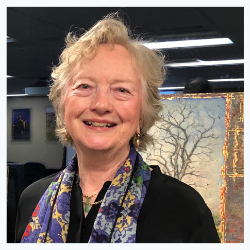Patricia Silbert |
| Artist Statement Native Americans have said that “Art is prayer made visible.” These paintings come from time spent in that meditative state. Walking along the Potomac in Spring I feel a numinous presence, everything is blooming, growing, cleansing, waking up. Being in the company of a great tree beginning to leaf out, giving us oxygen, shade, this beauty fills me with gratitude for what we now enjoy, but it is also a reminder of the increasingly grave threats to our natural environment and to our survival. |
Sacred Space–Landscape with Buddha and Goddess Protection |
Biographical Essay Throughout my life I see two themes that seem to flow through my work. The main theme comes from an early memory. London, 1947. I was seven or eight years old walking with my mother and sister along a busy city street in the late-afternoon cold and rain. Just in front of us a woman pushing a baby carriage, dropped her ration card. Only I noticed. Without thinking, I rushed up, picked up the card and handed it to the mother. She was almost over-whelmed with gratitude, thanking me profusely. I felt so good, so happy that I had done that. At that time in England without a ration card, you couldn’t buy food to eat. Ration cards were important. My mother hardly noticed this little drama, the rain and the cold were so oppressive. So we carried on. Only I knew what I had done and how good I felt. That memory of being so happy helping that woman has stayed with me. It fed my determination to work as a graphic artist for the U.S. poverty program, OEO, and then volunteering at Christ House, a hospital for homeless people, and for five years of giving a weekly therapeutic clay workshop for homeless women at N Street Village. I took this clay workshop to various healing centers in the U.S. and to Findhorn, Scotland. At fifty, painting full-time, I needed a change of direction, a more spiritual life, something intangible. I went back to school, studied psychiatry, learned to write, traveled…went to Ladakh, India and fell in love with ancient Buddhist art. And then I searched out a Jungian woman therapist. I said I wanted to be more creative…not really knowing what I was asking for. But the process had started, and is still going on. Now I see that my pleasure producing paintings that portray our need to revere the earth seems to have a lineage. And it follows that the second of these two themes I mentioned is art and my desire to produce and use art to help others. Somehow I seem to have been doing this all along. And up to now I never saw all this clearly, maybe I didn’t see it at all. A few years ago, I traveled to the Gobi Desert, a treeless expanse of vast sand dunes and ruins to a small precious oasis: a shrinking lake and a few trees. There in hundreds of man-made caves is preserved a treasure trove of Buddhist art. These are the Mugao Caves, carved into a limestone cliff, sculpted and painted by Buddhist monks and artisans from 348 AD to 1400 AD. Some six hundred caves are filled with images of Buddha, Bodhisattvas, and tranquil landscapes with people, horses and sheep, ancient visions of paradise. What a stark contrast to the surrounding dessert. Forgotten for centuries, these caves were rediscovered recently and preserved for us to contemplate and learn...something. We all need proximity to nature, to walk by rivers and fields, up mountains, through forests and parks. In these quiet places our souls are fed. We can find peace and grow as compassionate beings–compassion not just for each other but for the natural world, the green spaces, ancient trees and forests now in peril and in need our protection. Sitting among bluebells by the river in April, I wish for the help of angels, Bodhisattvas, Goddesses and Buddhas. I summon their aid to preserve this earthly beauty, this wildness. These images are from the Potomac River shore, from Ireland, from the 11th cen. Buddhist Monastery, Alchi, in Ladakh, India, and from centuries of Buddhist art in the Mugao Caves, Dunhuang, China. BACK TO GALLERY Your feedback on the Gallery is welcome. Please email it to Gallery@jung.org |

